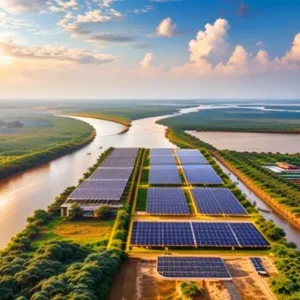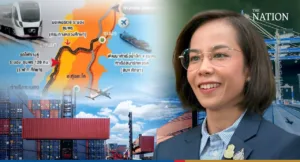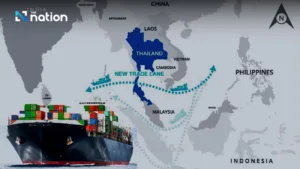China considers Thailand Land Bridge to Divert Traffic from Malacca Straits
Thailand with the support of China is promoting intraregional trade and investment. The “Mekong Economic Belt” electrification is an offshoot as Electric Riverine & Coastal Transport scheme. The utilisation of rivers for large and heavy cargo is a critical component of Thailand’s transport policy. Waterways have abundant idle capacity and transporting by inland waterway reduces CO2 emissions . The regulatory regime for waterways does not entail a complicated permit or licensing system for large and heavy goods transports compared to road transport. Wind turbine components, cable drums, coal, hydrocarbon bowsers and cylinders and other bulk commodities can be transported by inland waterways and energy and storage hubs established all along the waterways navigation routes. Germany has initiated a pilot project early this year in collaboration with relevant industry stakeholders.
 Credit : Longmekong
Credit : Longmekong
Thailand has been endeavouring to attract investment to fund its 90 km road and rail landbridge between the Gulf of Thailand and the Andaman Sea. The feasibility study is underway and if the outcome of the study is positive work would commence by the year 2030. In the perspective of advancing regional economic integration Thailand launched a “Project on Special Economic Zones (SEZ) Promotion for Intra-Regional Trade in the Lancang-Mekong (LM) Region” also known as “SEZ Project.” The SEZ Project is designed to bolster intra-regional trade within the LM region by promoting Thailand’s SEZs and the project includes countries of Thailand , People’s Republic of China ,Cambodia, Lao PDR, Myanmar and Viet Nam and the SEZ project is spread over the period 2023 to 2026.
China’s Strategic Interest & Halal Products
Significantly the People’s Republic of China is arranging funding from the Lancang-Mekong Cooperation Special Fund as strategically the Landbridge will provide an alternative route for Chinese trade that could bypass Singapore and the Straits of Malacca. The Landbridge logistic Corridor is expected to cost around $28 billion however, formal assent is awaited since China traditionally mooted the concept of a deep-water canal maritime route across Thailand for China bound vessels. China remains obsessed with a modern reworking of a centuries old plan to dredge a canal through the Isthmus of Kra. China through utilising SEC desires to explore potential to become a halal food products hub as the region borders Malaysia which is predominantly Islamic. The Landbridge is likely to reduce travel time by an average of four days between the Indian and Pacific Oceans and reduce transportation costs by 15%. For a business entity shipping goods from India’s major port Chennai ,on the Coromandel Coast, to Yokohama the Gateway Port for Tokyo savings up to 5 days and 4 % in costs can take place.
 Credit : The Nation-Thailand
Credit : The Nation-Thailand
Thailand not Putting all Eggs in One Basket
Thailand remains open to all categories of investors especially those reliant on Middle Eastern source hydrocarbons cargoes through the Straits of Malacca destined for China and East Asia with consumer goods flowing the other way.
Thailand Developing Deep Sea Ports along SEZ
Thailand’s comprehensive economic master plan identifies 10 border provinces to establish SEZs offering lucrative incentives, grant of privileges and introducing measures to promote investment in 13 groups encompassing 89 types of activities within the SEZs. Crucially, these initiatives dovetail with the Land Bridge Project, an integral component of Thailand’s Southern Economic Corridor program. The project will encompass the building of deep sea ports at Ranong on Thailand’s Andaman coast and at Chumphon on the Gulf of Thailand. Situated roughly 90 km apart and at times termed as “One Port Two Sides” the initiative aims to connect the Andaman Sea to the Gulf of Thailand via transit hubs in Ranong and Chumphon provinces.Such a transport corridor may threaten Singapore Ports regional dominance despite its port related activities being a small component of its GDP. The Chumphon deep-sea port to Ranong deep-sea port , goods transport system between the ports as well as motorways on land and double track rail links between the ports are envisaged to be developed as integral components of the plan.
 Credit : The Nation-Thailand
Credit : The Nation-Thailand
Thailand has installed solar panels on its cargo barges navigating its inland waterways and is saving on fuel costs and curbing carbon emissions.Riverine and wetland based solar plants do not induce untimely precipitation thereby causing flooding nor consume land which can be otherwise utilised. Policy makers in Pakistan , on the same pattern , should gear up efforts to convince Chinese investors to enter Pakistan’s maritime sector and link inland waterways from the Northern borders to seaports as well as establish a landbridge and logistic and freight corridor from the coast of Pakistan extending strategic outreach to the Central Asian countries and China’s hinterland.
Author : Nadir Mumtaz
Credit :
https://www.egtc-rhine-alpine.eu/rhine-alpine-news/rhine-alpine-news-14-03-2024/
https://www.voanews.com/a/thailand-drums-up-investment-for-strategic-landbridge-/7405320.html
https://www.nationthailand.com/thailand/economy/40032451
https://asia.nikkei.com/Opinion/Thailand-s-Landbridge-will-bring-East-and-West-closer-together
https://longmekong.substack.com/p/lancang-mekong-sezs?
r=1pbodw&utm_campaign=post&utm_medium=web&triedRedirect=true

Leave A Comment